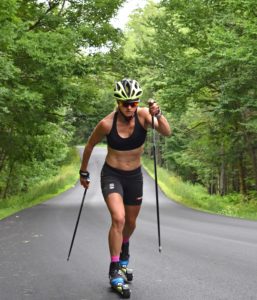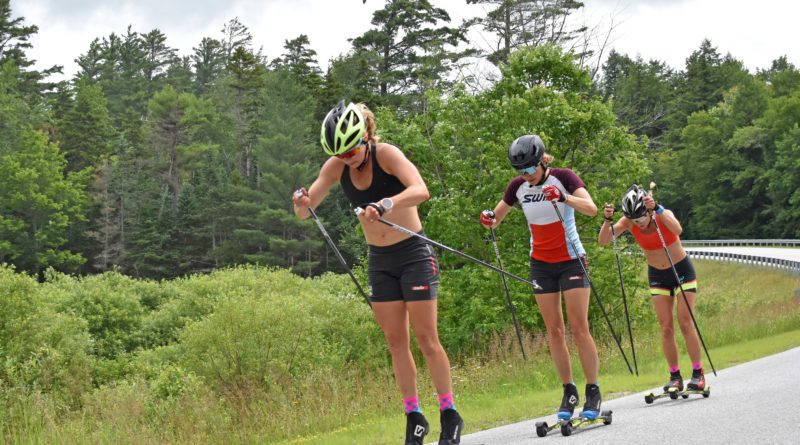A Week in Jessie Diggins’ Pain Cave
On a ripe June morning at the base of Stratton Mountain in Vermont, Jessie is squatting down in the dirt and lifting a volleyball-sized boulder to her chest. Then the power-packed 5-foot-4-inch Olympic cross country skier suddenly springs up and heaves the rock high into the air like a shot put. No one marks the distance of her throw. No fans are there cheering her on. Jessie is simply grinding her way through a dryland training session worthy of a “Rocky” montage.
When Jessie and teammate Kikkan Randall won their historic gold medal in the women’s team sprint freestyle race, their victory was the U.S. Women’s Cross Country Ski Team’s first Olympic medal ever. It was one of the greatest sprints to the finish line ever recorded in the history of sports. When Jessie bravely made her move in the final turn—surging from her third place position past the two best sprinters in the world to take the lead—our hearts were gorged with adrenaline from the spectacle of it all. Here was a pint-sized underdog from tiny Afton, Minnesota, on the world’s biggest stage, roaring from behind and ruthlessly going for the win. For days afterward, I openly wondered how the hell she pulled it off. My curiosity led me to meet her in Stratton, Vt where I went to interview her for a book project and, more importantly, visit the workshop that built Jessie into a world beater. There was just one catch to my spending a week with Jessie: she insisted that I train with her. It was a very sincere gesture, albeit a ridiculous one (I was 45 years old with a body built like a keg on legs). I naturally had reservations about working out with an Olympian. But Jessie is contagiously positive and I couldn’t pass up the chance to experience firsthand the forces that shape her. So it was that I found myself, a runty middle-aged hobbit, on the side of Stratton Mountain, a ski hill with an elevation close to 4,000 feet and the highest peak in the Southern Green Mountains, about to be destroyed by a smiling 27-year-old Energizer Bunny.
Our morning hike would be the first of three workout sessions I was to endure, and it barely scratched the surface of the absurd amount of training Jessie would put in that week. Despite reaching the pinnacle of her sport, the bedrock of Jessie’ athletic ethos—humility and trusting in her training process—has remained unchanged since winning gold. Jessie continues to work out twice a day, six days a week as part of her regimented training program. In a sports culture that aggressively focuses strictly on results, Jessie refreshingly views her career as one that is not to be solely judged by medals and race results.
“For me, only being results-orientated is not the way to go. Because there are so many things you can’t control that could affect whether you win or lose,” Jessie says. “The one thing I can control is showing up to the start line knowing I’ve done everything in my power to be ready to go. For the last 10 years, I’ve put skiing first. I’ve kept it balanced, kept it fun. But every training session I’ve gone out there and not slacked off. Success for me is looking back and not having to say, ‘I should’ve trained harder.’”Any doubts about her effort level were erased in the first few minutes of our time on Stratton Mountain, hiking on a steep gravel service road. She climbed up for seven minutes, then retreated back down the mountain for three minutes, and repeated that process—seven up, three down—until she reached the top. In doing so, she climbed the mountain not once, but twice. Harder still, instead of simply climbing, Jessie was mimicking a cross country ski stride the entire time, bounding up the mountain with ski poles in a process called “moose hoofing.”
While I dissolved into a sweaty schmutz, Jessie quickly reached a level three pace—meaning her body was hovering around the point where she can feel her muscles burn. At this pace and beyond, Jessie sets up residence in an aerobic torture chamber she’s nicknamed “the pain cave,” which is located at the convergence of her body and mind. For years, Jessie has trained both her physical body and her mental state to straddle this threshold between dealing with the pain and quitting. “Suffering is what I know how to do best,” Jessie says.
Jessie may be an Olympic gold medalist and FIS Cross Country World Cup champion, but she’s admittedly not the most technical skier or elite strategist in her sport. She also doesn’t possess raw speed. What she does have is a single intangible that defines her: “I know how to push my body to its outer limits, hold it there, and then push just a little bit more.”
During her gold medal race, Jessie made a mid-race decision to push the pace of the lead pack in her second lap in an attempt to drain her opponents’ tanks so they’d be empty for the final third lap and eventual sprint. Up on Stratton Mountain, a world away from the Winter Olympics, I saw the same stern race face she wore in South Korea. She was feeling the pain of the incline, and her face contorted into pure focus. She held her pace and kept pushing forward up the mountain at a punishing speed. Her breath grew slightly ragged but she remained steadfast, not giving a single inch to the pain that was now rising in her like a flood.
After a mere four-hour break to shower, eat lunch, and watch “Grey’s Anatomy” on Netflix, Jessie was back at it, at a strength training session at the Stratton Mountain Ski School. Our second workout of the day was a mix of more cardio, weights, and CrossFit. With Kendrick Lamar’s “Loyalty” blasting through the gym, Jessie was effervescent in spirit and decked out in various shades of neon, including bright pink socks. She was also a complete badass. Here in the gym is where Jessie fine-tunes the engine that allows her to epically surge down the homestretch during races, and she didn’t waste a second in gaining all she could from every rep of every exercise.
First, we rode spin bikes to warm up. Within 10 minutes, I felt psychotic from the heat and flop sweat. Next to me, Jessie pedaled at an insane pace, completely upright and on her phone, preparing an offer for a house. “It’s got a garage and one-and-a-half bathrooms!” she exclaimed excitedly as she scrolled through her email, never once breaking her intense stride.
Next, she did 10 sets of eight pull-ups in between weight training stations. I crawled into the fetal position as she walked across a tightrope, balancing while simultaneously heaving a medicine ball onto the rubber floor and catching it on its bounce back. (Yeah, that happened.) After two hours, I left the gym so tired I promptly collapsed into my hotel bed with the weight of a corpse.

Photo: Tom Horrocks/U.S. Ski & Snowboard
The next day at 9am sharp was our third training session, the one in which I became roadkill. To build her endurance, Jessie was out on an hour-and-a-half long roller ski on the deserted roads that climb through the rolling Green Mountains. She was skiing with members of the U.S. women’s cross country ski team. They skied in rhythmic unison, a locomotive of ponytails and sinewy muscle. I, on the other hand, rode Jessie’ bike as the caboose. I tapped out after just 20 minutes, during which, under an oven broiler of a sun, I rode up a steep mountain road for nine straight minutes (!) and my body melted like the freak at the end of “The Raiders of the Lost Ark.”
Our three workouts were only a fraction of her weekly regiment, too. Over the course of the week, Jessie would amazingly endure seven more hours of intense roller skiing (sprints and long distance runs), five more hours of strength training, and a three hour run on the Appalachian Trail. And that was considered her easy week.
Jessie knows winter skiers are made in the summer. It is a truth that fills her bones like marrow. That’s why she was out there grinding in the wilderness. Climbing mountains, hurling boulders, and on-road roller skiing for hours was where she was forged into a champion. In Vermont and at the infamous Snow Farm in New Zealand was where the pain was made malleable, bending the fire inside of her muscles into the steel that fills her veins.
There was a moment on Stratton Mountain during that first workout that solidified Jessie’ badassery. Near the top we came upon a crew of construction workers doing maintenance on the service road. The men were grizzled and snorting and intimidatingly blocking the road with their dump trucks and rumbling skid steer. I loitered on their periphery thinking that it would be a good time to stop and turn around. We were almost to the top anyway, and Jessie had already done more than enough. But she unrelentingly charged straight ahead at the construction zone. Focused in her mind was her upcoming four-month winter professional season in Europe. It may have only been June, but the hike up Stratton Mountain was another necessary, utilitarian chore Jessie knew she had to complete to build her base conditioning to continue to compete at the highest level.
As she approached the horde of working men and their heavy machinery, her stern race face was back and it was clear that nothing was going to stand in her way. To Jessie, no obstacle is insurmountable. Not the barren desert of a four-decade American medal drought in cross country skiing at the Olympics. Not her legendary opponents from Norway and Sweden. Not the unfathomable volume of her training hours. Not the vice grip of nerves on race day. Not the suffocating confines of her pain cave. And certainly not the industrial roadblock that was in front of her now. She did not back down a single inch, and the men paused their labor to let her pass. Jessie was an athlete at work and she had a job to do. Seven up, three down. No matter what, she was determined to finish climbing this mountain. Twice. `
Todd Smith is the co-author of Jessie Diggins’ of her story Brave Enough.

